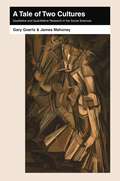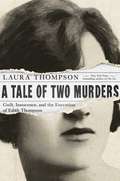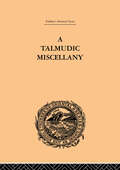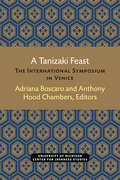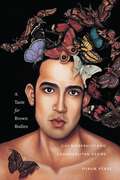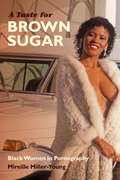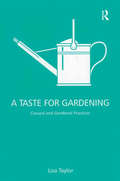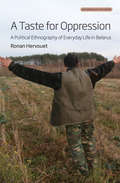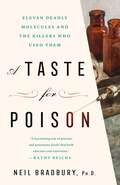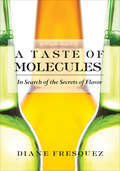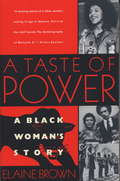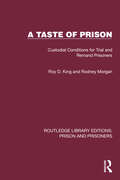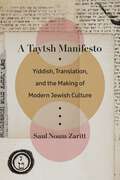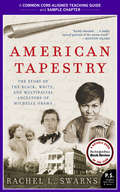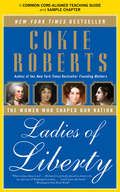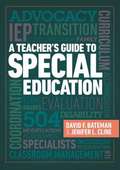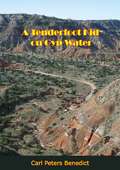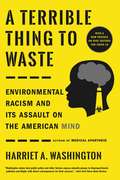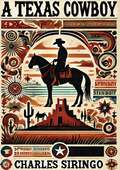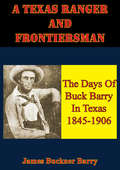- Table View
- List View
A Tale of Two Cultures: Qualitative and Quantitative Research in the Social Sciences
by James Mahoney Gary GoertzSome in the social sciences argue that the same logic applies to both qualitative and quantitative methods. In A Tale of Two Cultures, Gary Goertz and James Mahoney demonstrate that these two paradigms constitute different cultures, each internally coherent yet marked by contrasting norms, practices, and toolkits. They identify and discuss major differences between these two traditions that touch nearly every aspect of social science research, including design, goals, causal effects and models, concepts and measurement, data analysis, and case selection. Although focused on the differences between qualitative and quantitative research, Goertz and Mahoney also seek to promote toleration, exchange, and learning by enabling scholars to think beyond their own culture and see an alternative scientific worldview. This book is written in an easily accessible style and features a host of real-world examples to illustrate methodological points.
A Tale of Two Murders: Guilt, Innocence, And The Execution Of Edith Thompson
by Laura ThompsonA riveting account of the notorious “Ilford murder” by the New York Times bestselling author of The Six <P><P> The death penalty is never without its ethical conflicts or moral questions. Never more so than when the person being led to the gallows may very well be innocent of the actual crime, if not innocent according social concepts of femininity. <P><P>A Tale of Two Murders is an engrossing examination of the Ilford murder, which became a legal cause ce´le`bre in the 1920s, and led to the hanging of Edith Thompson and her lover, Freddy Bywaters. On the night of October 3, 1922, as Edith and her husband, Percy, were walking home from the theatre, a man sprang out of the darkness and stabbed Percy to death. The assailant was none other than Bywaters. <P><P>When the police discovered his relationship with Edith, she—who had denied knowledge of the attack—was arrested as his accomplice. Her passionate love letters to Bywaters, read out at the ensuing trial, sealed her fate, even though Bywaters insisted Edith had no part in planning the murder. They were both hanged. Freddy was demonstrably guilty; but was Edith truly so? <P><P>In shattering detail and with masterful emotional insight, Laura Thompson charts the course of a liaison with thrice-fatal consequences, and investigates what a troubling case tells us about perceptions of women, innocence, and guilt.
A Talmudic Miscellany: A Thousand and One Extracts from The Talmud The Midrashim and the Kabbalah
by Paul Isaac HershonThis is Volume III of six in a series on the Ancient Near East. Originally published in 1880, this is a succinct account of the Talmud with its siz orders (Sedarim), seventy-one Massictoth and 633 Perakim, and 4187 Mishnaoith. A considerable part of the Mishna has been at different times translated into English and other modern languages, and to many theologians it has been known as a whole by the magnificent work of Surenhusius.
A Tanizaki Feast: The International Symposium in Venice (Michigan Monograph Series in Japanese Studies #24)
by Anthony Hood Chambers Adriana BoscaroThis volume presents 18 eighteen essays, written by scholars from six countries, on Tanizaki Jun’ichiro (1886–1965), one of the great writers of the 20th century. The essays were originally prepared for a landmark international symposium in Venice in 1995, at which 22 speakers addressed an audience of about two hundred students and scholars in the Aula Magna of the University of Venice. Topics include Tanizaki’s fiction, plays, and film scenarios; his aesthetics; his place in Japanese intellectual history; his depiction of the West; his use of humor; and film adaptations of his works. In 1964 Tanizaki was elected to honorary membership in the American Academy and Institute of Arts and Letters, the first Japanese to be so honored; and it is widely believed that he was being considered for the Nobel Prize in Literature.
A Taste for Brown Bodies: Gay Modernity and Cosmopolitan Desire (Sexual Cultures #23)
by Hiram PérezWinner, LGBT Studies Lammy Award presented by Lambda LiteraryNeither queer theory nor queer activism has fully reckoned with the role of race in the emergence of the modern gay subject. In A Taste for Brown Bodies, Hiram Pérez traces the development of gay modernity and its continued romanticization of the brown body. Focusing in particular on three figures with elusive queer histories—the sailor, the soldier, and the cowboy— Pérez unpacks how each has been memorialized and desired for their heroic masculinity while at the same time functioning as agents for the expansion of the US borders and neocolonial zones of influence. Describing an enduring homonationalism dating to the “birth” of the homosexual in the late 19th century, Pérez considers not only how US imperialist expansion was realized, but also how it was visualized for and through gay men. By means of an analysis of literature, film, and photographs from the 19th to the 21st centuries—including Herman Melville’s Billy Budd, Anne Proulx’s “Brokeback Mountain,” and photos of abuse at the Abu Ghraib prison—Pérez proposes that modern gay male identity, often traced to late Victorian constructions of “invert” and “homosexual,” occupies not the periphery of the nation but rather a cosmopolitan position, instrumental to projects of war, colonialism, and neoliberalism. A Taste for Brown Bodies argues that practices and subjectivities that we understand historically as forms of homosexuality have been regulated and normalized as an extension of the US nation-state, laying bare the tacit, if complex, participation of gay modernity within US imperialism.
A Taste for Brown Sugar: Black Women in Pornography
by Mireille Miller-YoungA Taste for Brown Sugar boldly takes on representations of black women's sexuality in the porn industry. It is based on Mireille Miller-Young's extensive archival research and her interviews with dozens of women who have worked in the adult entertainment industry since the 1980s. The women share their thoughts about desire and eroticism, black women's sexuality and representation, and ambition and the need to make ends meet. Miller-Young documents their interventions into the complicated history of black women's sexuality, looking at individual choices, however small--a costume, a gesture, an improvised line--as small acts of resistance, of what she calls "illicit eroticism." Building on the work of other black feminist theorists, and contributing to the field of sex work studies, she seeks to expand discussion of black women's sexuality to include their eroticism and desires, as well as their participation and representation in the adult entertainment industry. Miller-Young wants the voices of black women sex workers heard, and the decisions they make, albeit often within material and industrial constraints, recognized as their own.
A Taste for Gardening: Classed and Gendered Practices
by Lisa TaylorIs the garden a consumption site where identities are constructed? Do gardeners make aesthetic choices according to how they are positioned by class and gender? This book presents the first scholarly analysis of the relationship between media interest in gardening and cultural identities. With an examination of aesthetic dispositions as a symbolic mode of communication closely aligned to peoples' identities and drawing on ethnographic data gathered from encounters with gardeners, this book maps a typology of gardening taste, revealing that gardening - how plants are chosen, planted and cared for - is a classed and gendered practice manifested in specific types of visual aesthetics. This timely and original book develops a new area within cultural studies while contributing to debates about lifestyle and lifestyle media, consumption, class and methodology. A must read for anybody concerned with or intrigued by the cultural construction of identification practices.
A Taste for Oppression: A Political Ethnography of Everyday Life in Belarus (Anthropology of Europe #6)
by Ronan HervouetBelarus has emerged from communism in a unique manner as an authoritarian regime. The author, who has lived in Belarus for several years, highlights several mechanisms of tyranny, beyond the regime’s ability to control and repress, which should not be underestimated. The book immerses the reader in the depths of the Belarusian countryside, among the kolkhozes and rural communities at the heart of this authoritarian regime under Alexander Lukashenko, and offers vivid descriptions of the everyday life of Belarusians. It sheds light on the reasons why part of the population supports Lukashenko and takes a fresh look at the functioning of what has been called 'the last dictatorship in Europe'.
A Taste for Oppression: A Political Ethnography of Everyday Life in Belarus (Anthropology of Europe #6)
by Ronan HervouetBelarus has emerged from communism in a unique manner as an authoritarian regime. The author, who has lived in Belarus for several years, highlights several mechanisms of tyranny, beyond the regime’s ability to control and repress, which should not be underestimated. The book immerses the reader in the depths of the Belarusian countryside, among the kolkhozes and rural communities at the heart of this authoritarian regime under Alexander Lukashenko, and offers vivid descriptions of the everyday life of Belarusians. It sheds light on the reasons why part of the population supports Lukashenko and takes a fresh look at the functioning of what has been called 'the last dictatorship in Europe'.
A Taste for Poison: Eleven Deadly Molecules and the Killers Who Used Them
by Neil Bradbury“A fascinating tale of poisons and poisonous deeds which both educates and entertains.” --Kathy ReichsA brilliant blend of science and crime, A TASTE FOR POISON reveals how eleven notorious poisons affect the body--through the murders in which they were used. As any reader of murder mysteries can tell you, poison is one of the most enduring—and popular—weapons of choice for a scheming murderer. It can be slipped into a drink, smeared onto the tip of an arrow or the handle of a door, even filtered through the air we breathe. But how exactly do these poisons work to break our bodies down, and what can we learn from the damage they inflict? In a fascinating blend of popular science, medical history, and true crime, Dr. Neil Bradbury explores this most morbidly captivating method of murder from a cellular level. Alongside real-life accounts of murderers and their crimes—some notorious, some forgotten, some still unsolved—are the equally compelling stories of the poisons involved: eleven molecules of death that work their way through the human body and, paradoxically, illuminate the way in which our bodies function. Drawn from historical records and current news headlines, A Taste for Poison weaves together the tales of spurned lovers, shady scientists, medical professionals and political assassins to show how the precise systems of the body can be impaired to lethal effect through the use of poison. From the deadly origins of the gin & tonic cocktail to the arsenic-laced wallpaper in Napoleon’s bedroom, A Taste for Poison leads readers on a riveting tour of the intricate, complex systems that keep us alive—or don’t.
A Taste of Molecules: In Search of the Secrets of Flavor (Women Writing Science Ser.)
by Diane FresquezA delicious exploration of what creates the flavors we love—and why our taste buds respond to them—in a fascinating, &“very pleasant and easy read&” (Flanders Today). In this unique scientific study of food, drink, and how the human taste buds sense taste, food journalist Diane Fresquez brings readers along on a journey of gastronomic discovery. She begins by following a Belgian beekeeper who uses science to give the ancient drink of mead (or &“honey wine&”) a modern taste-makeover. Fresquez then travels to Holland to learn how food memories are tested at a research center called the Restaurant of the Future. And elsewhere, she discovers how much skill it takes to make banana flavor in the lab, and experiments on a group of scientists during a surprise meal eaten in the dark. Stuffed with fascinating food facts, anecdotes from the author&’s own culinary life, and a selection of irresistible recipes (including a cocktail with dancing molecules), A Taste of Molecules is an exploration of the senses that will delight foodies and science enthusiasts alike.
A Taste of Power
by Elaine BrownBrown's account of her life at the highest levels of the Black Panther party's hierarchy. More than a journey through a turbulent time in American history, this is the story of a black woman's battle to define herself.
A Taste of Prison: Custodial Conditions for Trial and Remand Prisoners (Routledge Library Editions: Prison and Prisoners)
by Roy D. King Rodney MorganOriginally published in 1976, A Taste of Prison deals with a very sensitive area of concern in the system of trial and imprisonment in Britain at the time. It describes the conditions at Winchester Prison and Winchester Remand Centre for both adults and young persons who were held in custody before trial or who were awaiting sentence. Despite the fact that many of these persons would not subsequently be sent to prison by the courts, the conditions they experienced were in many respects no better and in some respects worse than those for persons sentenced to imprisonment. Moreover, as this study shows, the special provisions for these persons embodied in the Prison Rules and Standing Orders of the Prison Department often meant little in practice – either because they remained unaware of their rights or because they were unable to take them up for various reasons. The authors discuss the function of remands in custody within a changing prison system, analyse recent trends in the numbers of persons received into the prison system on remand, and assess their contribution to the prison population. The implications of the findings are discussed in the context of the prison building programme and the uses to which existing buildings could be put. Finally, the authors make a number of proposals for the improvement of the regime for remand prisoners.
A Taytsh Manifesto: Yiddish, Translation, and the Making of Modern Jewish Culture
by Saul Noam ZarittA Taytsh Manifesto calls for a translational paradigm for Yiddish studies and for the study of modern Jewish culture. Saul Noam Zaritt calls for a shift in vocabulary, from Yiddish to taytsh, in order to promote reading strategies that account for the ways texts named as Jewish move between languages and cultures. Yiddish, a moniker that became dominant only in the early twentieth century, means “Jewish” and thus marks the language with a single identity: of and for a Jewish collective. In contrast, this book calls attention to an earlier and, at one time, more common name for the language: taytsh, which initially means “German.” By using the term taytsh, speakers indicated that they were indeed speaking a Germanic language, a language that was not entirely their own. In time, when the word shifted to a verb, taytshn, it came to mean the act of translation. To write or speak in Yiddish is thus to render into taytsh and inhabit the gap between languages.A Taytsh Manifesto highlights the cultural porousness that inheres in taytsh and deploys the term as a paradigm that can be applied to a host of modern Jewish cultural formations. The book reads three corpora in modern Yiddish culture through the lens of translation: Yiddish pulp fiction, also known as shund (trash); the genre of the Yiddish monologue as authored by Sholem Aleichem and other prominent Yiddish writers; and the persistence of Yiddish as a language of vulgarity in contemporary U.S. culture. Together these examples help revise current histories of Yiddish while demonstrating the need for new vocabularies to account for the multidirectionality of Jewish culture. A Taytsh Manifesto develops a model for identifying, in Yiddish and beyond, how cultures intertwine, how they become implicated in world systems and empire, and how they might escape such limiting and oppressive structures.
A Teacher's Guide to American Tapestry
by Rachel L. Swarns Amy JurskisFor teachers We know that the Common Core State Standards are encouraging you to reevaluate the books that you assign to your students. To help you decide which books are right for your classroom, each free ebook in this series contains a Common Core-aligned teaching guide and a sample chapter.This free teaching guide for An American Tapestry by Rachel L. Swarns is designed to help you put the new Common Core State Standards into practice."Riveting. . . . A microcosm of this country's story. . . . The real-life saga of struggle, survival, triumph and tragedy serves as an uplifting companion to Alex Haley's Roots."--USA TodayIn this extraordinary feat of genealogical research, author Swarns, a respected Washington-based reporter for the New York Times, tells the fascinating and hitherto untold story of Ms. Obama's black, white, and multiracial ancestors; a history that the First Lady herself did not know.At once epic, provocative, and inspiring, American Tapestry is more than a true family saga; it is an illuminating mirror in which we may all see ourselves.
A Teacher's Guide to Founding Mothers
by Cokie Roberts Amy JurskisFor teachersWe know that the Common Core State Standards are encouraging you to reevaluate the books that you assign to your students. To help you decide which books are right for your classroom, each free ebook in this series contains a Common Core-aligned teaching guide and a sample chapter.This free teaching guide for Founding Mothers by Cokie Roberts is designed to help you put the new Common Core State Standards into practice."Instructive and inspiring."--New York Times Book ReviewDrawing upon personal correspondence, private journals, and even favored recipes, Roberts reveals the often surprising stories of these fascinating women, bringing to life the everyday trials and extraordinary triumphs of individuals like Abigail Adams, Mercy Otis Warren, Deborah Read Franklin, Eliza Pinckney, Catherine Littlefield Green, Esther DeBerdt Reed, and Martha Washington--proving that without our exemplary women, the new country might never have survived.
A Teacher's Guide to Ladies of Liberty
by Cokie Roberts Amy JurskisFor teachersWe know that the Common Core State Standards are encouraging you to reevaluate the books that you assign to your students. To help you decide which books are right for your classroom, each free ebook in this series contains a Common Core-aligned teaching guide and a sample chapter.This free teaching guide for Ladies of Liberty by Cokie Roberts is designed to help you put the new Common Core State Standards into practice."Roberts weaves a colorful story of the trials and triumphs of the women of the post-Revolution. . . . Ladies of Liberty is not only informative but entertaining."--Denver PostRecounted with insight and humor, and drawing on personal correspondence, private journals, and other primary sources, many of them previously unpublished, here are the fascinating and inspiring true stories of first ladies and freethinkers, educators and explorers.Featuring an exceptional group of women--including Abigail Adams, Dolley Madison, Rebecca Gratz, Louise Livingston, Sacagawea, and others--Ladies of Liberty sheds new light on the generation of heroines, reformers, and visionaries who helped shape our nation, finally giving these extraordinary ladies the recognition they so greatly deserve.
A Teacher's Guide to Special Education
by David Bateman Jenifer ClineDespite the prevalence of students with disabilities in the general education classroom, few teachers receive training on how to meet these students' needs or how to navigate Despite the prevalence of students with disabilities in the general education classroom, few teachers receive training on how to meet these students' needs or how to navigate the legally mandated processes enumerated in the Individuals with Disabilities Education Act (IDEA). What is their role? What are their responsibilities? What are the roles and rights of parents? And what must all teachers do to ensure that students with disabilities and other special needs receive the quality education they're entitled to? In this practical reference, David F. Bateman--bestselling author of A Principal's Guide to Special Education --and special education administrator Jenifer L. Cline clarify what general education teachers need to know about special education law and processes and provide a guide to instructional best practices for the inclusive classroom. Topics covered include The pre-referral, referral, and evaluation processes Individualized education programs (IEPs) and the parties involved Accommodations for students who do not quality for special education, including those covered by Section 504 Transition from preK to K-12 and from high school to postschool life Classroom management and student behavior Educational frameworks, instructional strategies, and service delivery options Assessment, grades, graduation, and diplomas The breadth of coverage in this book, along with its practical examples, action steps, and appendixes covering key terms and definitions will provide the foundation all K-12 teachers need to successfully instruct and support students receiving special education services. It's an indispensable resource for every general education classroom. the legally mandated processes enumerated in the Individuals with Disabilities Education Act (IDEA). What is their role? What are their responsibilities? What are the roles and rights of parents? And what must all teachers do to ensure that students with disabilities and other special needs receive the quality education they're entitled to? In this practical reference, David F. Bateman--bestselling author of A Principal's Guide to Special Education --and special education administrator Jenifer L. Cline clarify what general education teachers need to know about special education law and processes and provide a guide to instructional best practices for the inclusive classroom. Topics covered include The pre-referral, referral, and evaluation processes Individualized education programs (IEPs) and the parties involved Accommodations for students who do not quality for special education, including those covered by Section 504 Transition from preK to K-12 and from high school to postschool life Classroom management and student behavior Educational frameworks, instructional strategies, and service delivery options Assessment, grades, graduation, and diplomas The breadth of coverage in this book, along with its practical examples, action steps, and appendixes covering key terms and definitions will provide the foundation all K-12 teachers need to successfully instruct and support students receiving special education services. It's an indispensable resource for every general education classroom.
A Technomoral Politics: Good Governance, Transparency, and Corruption in India
by Aradhana SharmaExamining anticorruption battles and transparency laws to ask: what makes for good governance, and can it limit liberal democratic politics as much as encourage it? Good governance is meant to empower citizens, increase democratic participation, and make states transparent and accountable, yet this liberal democratic imperative can also promote populist authoritarian rule. Bringing together discourses on ethical goodness with the technicalities of governance as expressed in laws and policies, Aradhana Sharma develops the concept of &“technomoral politics&” to navigate this fraught topic. With a focus on the work of activists, citizens, and state officials, she offers an ethnographic account of the contradictions and dangers of good-governance politics in twenty-first-century India. A Technomoral Politics follows the evolution of a group of activists in New Delhi led by Arvind Kejriwal from 2008 to 2014 as they morphed from a protransparency NGO to a mass movement against state corruption to a populist party that promised to change the political system through laws and policies. Sharma explores the technomoral framing of state opacity and corruption as well as the limits of the law in resolving these issues, probing such themes as the contradictory relationship between transparency and bureaucracy and the classed and gendered nature of democratic state institutions. By examining scalar dimensions of good-governance politics, from the hyperlocal work of activists to global trends, A Technomoral Politics illuminates the paradoxes, limits, and risks of a system that is meant to spread liberal democratic principles but that also ends up promoting antidemocratic, populist-authoritarian forms of rule. Retail e-book files for this title are screen-reader friendly.
A Tenderfoot Kid on Gyp Water
by Carl Peters BenedictStill wet behind the ears in 1894, Carl Benedict was “crazy to get away and work on the range.” In the summer, he hooked up with a big outfit called the Figure 8 to round up cattle in the Texas Panhandle. Out of that experience came this book, published fifty years later, about what it was really like to be a cowboy in some ornery country checkered by canyons and gyp water springs.A Tenderfoot Kid on Gyp Water is all the more engaging for being unpretentious. During daily drives, the Kid learns how to ride, rope, brand, and hobble cattle and horses. The cowboys who teach him are not stereotyped or romanticized. Life on the range is too immediate and real to require Hollywood heroics. But every day brings drama: blockbuster fights of fierce wild bulls, treacherous river crossings with thousands of cattle in the water at once. Some nights bring thunderstorms and stampedes. And through it all those “cattle, horses, and also men who were not physically fit and healthy soon died or disappeared.”“One of the best books ever written on the Texas range.”—William S. Reese, Six Score: The 120 Best Books on the Range Cattle Industry.“Intelligence, [a] sense of humor, rightness of heart, observant sympathy for nature, and gentle sensitiveness [are] manifest throughout A Tenderfoot Kid on Gyp Water.”—J. Frank Dobie.
A Terrible Thing to Waste: Environmental Racism and Its Assault on the American Mind
by Harriet Washington<P><P>Did you know...Middle-class African American households with incomes between $50,000 and $60,000 live in neighborhoods that are more polluted than those of very poor white households with incomes below $10,000. <P><P>When swallowed, a lead-paint chip no larger than a fingernail can send a toddler into a coma -- one-tenth of that amount will lower his IQ. <P><P>Nearly two of every five African American homes in Baltimore are plagued by lead-based paint. Almost all of the 37,500 Baltimore children who suffered lead poisoning between 2003 and 2015 were African American.From injuries caused by lead poisoning to the devastating effects of atmospheric pollution, infectious disease, and industrial waste, Americans of color are harmed by environmental hazards in staggeringly disproportionate numbers. <P><P>This systemic onslaught of toxic exposure and institutional negligence causes irreparable physical harm to millions of people across the country-cutting lives tragically short and needlessly burdening our health care system. But these deadly environments create another insidious and often overlooked consequence: robbing communities of color, and America as a whole, of intellectual power. <P><P>The 1994 publication of The Bell Curve and its controversial thesis catapulted the topic of genetic racial differences in IQ to the forefront of a renewed and heated debate. <P><P>Now, in A Terrible Thing to Waste, award-winning science writer Harriet A. Washington adds her incisive analysis to the fray, arguing that IQ is a biased and flawed metric, but that it is useful for tracking cognitive damage. <P><P>She takes apart the spurious notion of intelligence as an inherited trait, using copious data that instead point to a different cause of the reported African American-white IQ gap: environmental racism - a confluence of racism and other institutional factors that relegate marginalized communities to living and working near sites of toxic waste, pollution, and insufficient sanitation services. <P><P>She investigates heavy metals, neurotoxins, deficient prenatal care, bad nutrition, and even pathogens as chief agents influencing intelligence to explain why communities of color are disproportionately affected -- and what can be done to remedy this devastating problem. Featuring extensive scientific research and Washington's sharp, lively reporting, A Terrible Thing to Waste is sure to outrage, transform the conversation, and inspire debate.
A Test of the General Validity of the Heckscher-Ohlin Theorem for Trade in the European Community
by Dalia HakuraA report from the International Monetary Fund.
A Texas Cowboy, or, Fifteen Years on the Hurricane Deck of a Spanish Pony [Illustrated Definite 1950 edition]
by Charles Siringo"A Texas Cowboy, or, Fifteen Years on the Hurricane Deck of a Spanish Pony [Illustrated Definite 1950 edition]" by Charles Siringo is a thrilling and authentic account of life in the American West, capturing the essence of the cowboy experience during the late 19th century. This definitive 1950 edition, enhanced with illustrations, brings Siringo's vivid tales to life, offering readers a compelling glimpse into the rugged and adventurous world of the Texas cowboy.Charles Siringo, a legendary figure in Western history, chronicles his fifteen years as a cowboy, providing an unparalleled insider's perspective on the trials, triumphs, and tribulations of life on the open range. From cattle drives across vast prairies to encounters with notorious outlaws, Siringo's narrative is filled with exciting episodes and colorful characters that paint a vivid picture of the Old West.The book covers various aspects of cowboy life, including the hard work, camaraderie, and the constant challenges posed by the untamed landscape and unpredictable weather. Siringo's writing is characterized by its authenticity and straightforward style, reflecting his genuine experiences and deep connection to the cowboy way of life. He shares not only the adventurous aspects of his career but also the personal moments of reflection and growth, offering a well-rounded portrayal of his journey."A Texas Cowboy" is more than just an adventure tale; it is a historical document that provides valuable insights into the culture and ethos of the American cowboy. This illustrated definitive edition is a must-read for history enthusiasts, Western aficionados, and anyone interested in the true stories of the American frontier.Charles Siringo's memoir stands as a testament to the enduring spirit of the cowboy and the rich legacy of the American West. With its engaging narrative and evocative illustrations, "A Texas Cowboy" continues to captivate and inspire readers, preserving the spirit of a bygone era.
A Texas Pioneer: Early Staging And Overland Freighting Days On The Frontiers Of Texas And Mexico
by August SantlebenStep into the rugged and adventurous world of the American frontier with August Santleben's A Texas Pioneer. This compelling autobiography offers an intimate and vivid account of life in 19th-century Texas, as experienced by one of its most colorful and resilient pioneers.August Santleben, a true frontiersman, recounts his journey from his early days as an immigrant to his ventures across the vast and untamed landscapes of Texas. A Texas Pioneer is rich with personal anecdotes and historical insights, capturing the challenges, dangers, and triumphs of pioneer life. Santleben's engaging narrative brings to life the spirit of exploration and determination that defined the era.Throughout the book, readers will encounter a wide array of experiences, from encounters with Native American tribes and battles with bandits to the daily struggles of ranching and farming. Santleben's detailed descriptions and heartfelt storytelling provide a genuine portrayal of the hardships and rewards of frontier life.A Texas Pioneer, also delves into significant historical events and figures that shaped Texas during the 19th century. Santleben offers a unique perspective on the social, political, and economic developments of the time, making this autobiography not only a personal memoir but also a valuable historical document.This book is an essential read for history enthusiasts, students of American history, and anyone fascinated by the pioneer spirit. August Santleben's A Texas Pioneer is a testament to the courage, ingenuity, and resilience of the individuals who helped shape the American West.Join August Santleben on his incredible journey through the wilds of Texas, and experience the adventures and challenges of a true Texas pioneer. A Texas Pioneer is a timeless and inspiring account that brings the rich history of the Lone Star State to life.
A Texas Ranger And Frontiersman: The Days Of Buck Barry In Texas 1845-1906
by James Buckner Barry"Although Jim Bowie and Davy Crockett were more celebrated, Buck Barry did as much or more to tame the Old Southwest. During a long and useful life he was a professional soldier, stock farmer, sheriff, and member of the legislature. His memoirs are never dull, and no wonder. In 1845 young James Buckner Barry joined the newly formed Texas Rangers and for the next twenty years his life was one of unremitting activity and danger. These pages show him fighting outlaws and Indians from the Red River to the Rio Grande. He served in the Mexican and Civil wars, coming out as a lieutenant colonel. Then he confronted the daily perils of ranching in Bosque County, Texas. Peace officer, legislator, "he served his people well even to the neglect of his private advantage." Such is the tribute of the historian James K. Greer, who edited Buck Barry's private papers and reminiscences and shaped them into this book."-Print ed.
